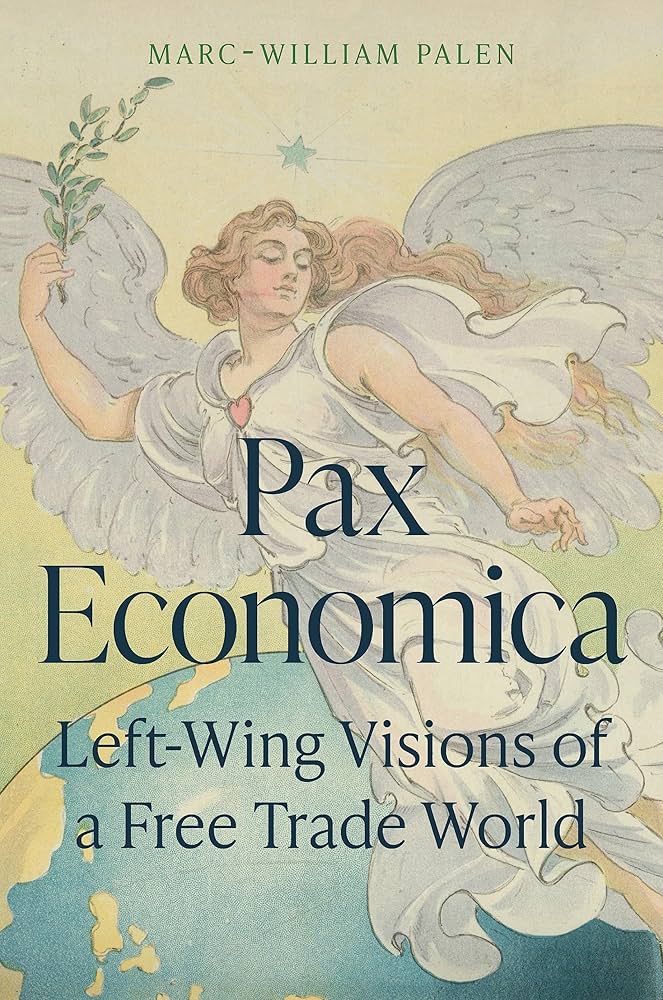
The history of the liberals, radicals, socialists, feminists, and Christians who advocated for free trade as the necessary accompaniment to anti-imperialism and peace is the subject of Marc-William Palen’s Pax Economica: Left-Wing Visions of a Free Trade World. Pax Economica was a term promoted by Jane Addams of the Women’s International League for Peace and Freedom, whose idealistic vision was of such a world after the catastrophe of the First World War (page 199).
Today, free trade is most often associated with neo-liberal economic thought but Palen demonstrates that its origins are rooted in nineteenth-century left-wing politics, with its advocates promoting a heady blend of peace, anti-imperialism, and free trade: a vision at odds with the powerful currents of nationalism, protectionism, and colonial expansion.
The book charts the continuous movements for free trade from the 1840s to the present day. Its scope is broad in time and space, with the core themes often intersecting with major events across the period. The vicissitudes of the drive for free trade as the harbinger of a peaceful world is prominent, and its mutability is closely considered and evaluated.
Palen reveals how, for some of its more left-wing adherents, free trade represented a challenge to imperialism and militarism. In its most idealistic form, it was held that free trade would create international bonds of union, dependence, and harmony which would make war obsolete. Suffice to say, that idealist vision has not materialized.
Nonetheless, the vision of a ‘Pax Economica’ evolved to include supranational regulation, and the establishment of post-1945 liberal institutions such as the United Nations (UN), International Monetary Fund (IMF), and the General Agreement on Trade and Tariffs (GATT) which did meet, albeit insipidly and ultimately disappointingly, their support for global governance and cooperation. Yet Palen’s work is not primarily a history of international institutions but rather a detailed study of the left-wing vision of globalism. In the main, this means a roll call of movements, pressure groups, and individuals, mostly those employing an ‘outsider strategy’ as a means of changing policy. The work is ambitious, immaculately researched, and a timely publication amid the resurgence of economic nationalism and geopolitical conflict.
The text, divided into six chapters, ranges over an extensive landscape, encompassing the anti-imperialism of free trade, Christian pacifism, socialist internationalism, feminism, and Marxism. The idealism conflating free trade, peace, and prosperity is well-delineated, and the intellectual antecedents well-identified and contextualized, with Richard Cobden, Henry George, and Norman Angell referenced throughout in multiple contexts. The geographical diaspora of free trade sentiments is a fine testimony to the vibrancy and durability of these ideas.
The book considers these developments, broadly defined, with short-hand organizing themes such as the ‘Marx-Manchester’ and ‘Marx-List’ traditions. Continuity of struggle and complexity of the tasks are keynotes of the work, from the battle against the systemic protectionism of the 1840s to the current disputes over trade liberalization and neoliberalism.
Indeed, divisions over the legitimacy of free trade principles were explicitly made with the publication of Friedrich List’s National System of Political Economy as early as 1841 at the height of the campaign for economic liberalization in Britain. Economic nationalism, as a counterpoint to free trade, features prominently, with List’s ‘infant industry’ framework and the ‘American System’ of Alexander Hamilton appearing equally, if not more, historically important, in the commercial policy of nations. The idea of tariffs as a shield against foreign competition, and more positively, as an economic development strategy, proved highly influential in the United States, Canada, Australia, Germany, and even Britain.
Free Trade has always been presented in many different guises, and Palen effectively demonstrates that it is intersectional and situational. It could be a liberal, socialist, or anti-colonial force, for the variegated ‘productive profile’ of nations meant it possessed different connotations and meanings on a country-specific basis. While viewed as a liberating measure in Victorian Britain, the same policy preferences led to it being considered by less-developed countries, such as India, Ireland, and China, as a tool of economic imperialism, used against territories which had ‘suffered under the yoke of British free-trade imperialism’ (page 109). Conversely, protectionism, while historically often reflecting the dominance of political and business elites, was often considered, especially in recent times, integral to the economic development of emerging states, and in anti-colonial national struggles. Hence the terminology of ‘Marx-List’ and ‘Marx-Manchester’ traditions as a way of understanding political economy preferences via national subjectivities and economic complexities. Undoubtedly owing to constraints of space, the book does not go far in its forensic analysis of divergent commercial policy preferences, and a particularly notable omission is the extent to which policy preferences were influenced by the fiscal demands of increasingly democratic electorates.
Chapters on free trade feminism and Christian pacifism demonstrate the continuing influence of Cobdenite ideas into the twentieth century. The final chapter takes the story up to the present day, charting the post-war Bretton Woods system, and the triumph of the Pax Americana and neoliberalism, with the caveat that economic nationalism aligned with infant-industry strategy continues to challenge the long-standing association between equity and free trade. Argentina is usefully highlighted as a case study of a nation adopting a growth strategy informed by Listian and American System ideas as ‘economic blueprints’ for development (page 196).
In a divided and unequal world, an absolutist stance for free trade has often been construed as entrenching inequality. Interestingly, free traders often reconciled these Global South infant-industry strategies as a rational, though hopefully temporary, response to Western neo-liberalism, which preached free trade but practiced protectionism. Most notable in that respect, despite the guiding principles of Reciprocity and Non-Discrimination promoted by the World Trade Organization, is the recent surge of regional trade agreements delimiting and protecting rather than expanding market access.
In some ways, the timing of the book’s publication in 2024 was unfortunate, and the idea that the ‘neo-liberal order has been placed on notice’, appears chimerical. With rising global geopolitical tensions, and war in Ukraine and Gaza, any notion of Pax Economica appears unlikely (page 222).
Nonetheless, the analysis within the book is broad-ranging, conceptually coherent, and highly informative. A particular strength is the ability of the author to convey the changing nature of free trade movements, yet while the breadth of the study is highly impressive, it does necessitate a sacrifice of depth in places.
The book is primarily an intellectual and institutional history with a plethora of organizations, acronyms, and an eclectic array of individuals. At times, it would have been useful to know how popular many of the cited organizations were, and how long they lasted. Some readers may find the numerous terms, ideologies, adjectives, and acronyms difficult to follow. Equally, the thematic approach means there is some reiteration and repetition.
Nomenclature is a little odd at times, with John Bright described as an ‘antislavery activist’ and Cobden as an ‘opponent of slavery’ (page 155). It is not that these descriptions are inaccurate but that they convey a limited view of individuals whose backstory is much wider than suggested by the description. There are also some contentious points, such as the claim that the Manchester School ‘envisaged the gradual decline of the nation-state, and with it the elimination of national rivalries and trade barriers’ (page 97). Despite its purported universalist and utopian principles, there existed many, maybe even Cobden himself, who supported free trade at least partly because it aligned with vested class and/or national interests. Self-interest could co-exist with or even be disguised by idealism. Indeed, trade agreements today, such as the USMCA, are examples of managed and negotiated free trade, which are a far cry from the voluntarist model promoted by free trade idealists portrayed within the book.
At times the book appears a somewhat breathless account (indicated by 65 pages of notes and a 20-page index) in covering so many events, times, and places but there is much to be gained from a close and careful reading of the text.
In sum, the book will interest scholars and general readers. It follows the tradition of ‘broad sweep’ history, informed by a considerable body of research and synthesis, and as such is thought-provoking, engaging, and interesting to read.
‘Pax Economica: Left-Wing Visions of a Free Trade World’ by Marc-William Palen was published in 2024 by Princeton University Press (ISBN: 978-0-69-119932-0). 309pp
 Gordon Bannerman is a professor teaching Business History at Wilfrid Laurier University and the University of Guelph-Humber, Ontario. His primary research interests focus on modern British political and economic history.
Gordon Bannerman is a professor teaching Business History at Wilfrid Laurier University and the University of Guelph-Humber, Ontario. His primary research interests focus on modern British political and economic history.